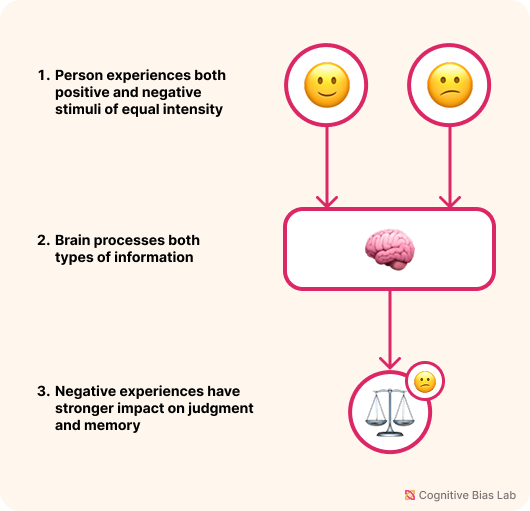Negativity Bias
Your progress on this bias test won't be saved after you close your browser.
Understanding Negativity Bias
Negativity Bias
Our brains are wired to react more strongly to negative experiences than positive ones. This skewed attention means one criticism can outweigh multiple compliments, affecting everything from mood to major decisions.
What is Negativity Bias?
Negativity bias is our tendency to give far greater weight to negative experiences or information than to positive or neutral data. This fundamental asymmetry in how we process information shapes our perceptions, decisions, and even memories.
Key Characteristics:
- Negative events command attention more quickly than positive ones
- Negative experiences create stronger memories that are more easily recalled
- Negative feedback feels more impactful regardless of the ratio of positive to negative input
- The bias operates largely below conscious awareness, making it difficult to counteract
Real-World Impact
Negativity bias explains why:
- A single critical comment can overshadow multiple compliments
- News headlines emphasize disasters and crises (they capture more attention)
- People ruminate on mistakes while taking successes for granted
- Risk-aversion often dominates decision-making even when potential gains outweigh risks
Evolutionary Purpose
This bias likely evolved as a survival mechanism. For our ancestors, paying special attention to potential threats (predators, poisonous plants, hostile tribes) had greater survival value than focusing on positive experiences. Those who were more attuned to danger were more likely to survive and pass on their genes.
In today's world, however, this ancient adaptation can lead to skewed perceptions, unnecessary anxiety, and missed opportunities for growth and connection.

Visual representation of Negativity Bias (click to enlarge)
Examples of Negativity Bias
Here are some real-world examples that demonstrate how this bias affects our thinking:
The Performance Review Paradox
During an annual review, a manager provides an employee with nine positive comments and one constructive criticism. Despite the overwhelmingly positive feedback, the employee fixates entirely on the single negative point, spending days worrying about it while barely registering the praise. This focus affects their confidence, productivity, and workplace satisfaction — all because the single negative comment carried more psychological weight than all the positive feedback combined.
The Product Review Distortion
A small business receives hundreds of 5-star reviews for their product online, but also gets three negative comments. Despite the overwhelmingly favorable ratio, the owner becomes obsessed with the negative feedback, making unnecessary product changes and experiencing significant anxiety. Meanwhile, potential customers reading reviews also give disproportionate weight to the few negative comments, potentially affecting their purchasing decisions despite the statistical insignificance of those few complaints.
How to Overcome Negativity Bias
Here are strategies to help you recognize and overcome this bias:
Implement the 3:1 Positivity Ratio
or each negative point, list at least three positives to counterbalance automatic negative weighting.
Interrupt and Reframe
When stuck on negativity, pause and ask what positives you're overlooking and whether the negative truly matters statistically.
Test Your Understanding
Challenge yourself with these questions to see how well you understand this cognitive bias:
A company launches a new product that receives 95% positive reviews, but sales are disappointing. What might explain this discrepancy?
Academic References
- Vaish A, Grossmann T, Woodward A. Not all emotions are created equal: the negativity bias in social-emotional development. Psychol Bull. 2008 May;134(3):383-403. doi: 10.1037/0033-2909.134.3.383. PMID: 18444702; PMCID: PMC3652533.
- Our cognitive bias toward novel, negative information may make new social groups seem less likeable. (n.d.). Association for Psychological Science - APS.
- Gazit, T., Bergman, Y. S., Hoffman, Y., Weissberger, G., & Shrira, A. (2025). The effect of positive and negative daily social media emotional experiences on older adults’ subjective age: Unveiling the negativity bias in WhatsApp groups. New Media & Society.